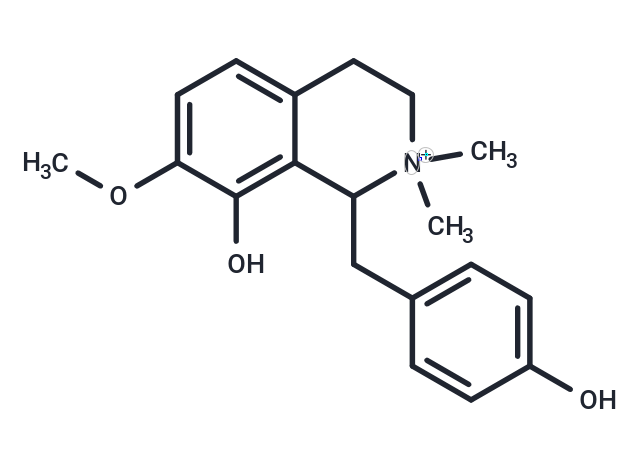Shopping Cart
- Remove All
 Your shopping cart is currently empty
Your shopping cart is currently empty

Oblongine chloride may have potential haemodynamic effects, it can cause a dose-dependent reduction of systolic and diastolic blood pressure, and that these effects are not mediated by α2-adrenergic receptor stimulation.

| Pack Size | Price | Availability | Quantity |
|---|---|---|---|
| 5 mg | Inquiry | Backorder | |
| 1 mL x 10 mM (in DMSO) | Inquiry | Backorder |
| Description | Oblongine chloride may have potential haemodynamic effects, it can cause a dose-dependent reduction of systolic and diastolic blood pressure, and that these effects are not mediated by α²-adrenergic receptor stimulation. |
| In vitro | Oblongine chloride (3 x 10(-5)-10(-3) M) caused concentration-dependent relaxation of ileum, an effect which was not blocked by propranolol (10(-6) M) alone or in combination with prazosin (3 x 10(-8) M), or by indomethacin (10(-6) M), but was reduced by desensitization of the preparation by prior exposure to 3 x 10(-5) M ATP and, at high concentrations of Oblongine, by a combination of propranolol and yohimbine (3 x 10(-6) M). 3. Oblongine chloride (10(-5)-3 x 10(-3) M) caused concentration-dependent relaxation of epinephrine-precontracted pulmonary artery. This effect was not affected by propranolol or by indomethacin but was significantly attenuated by pretreatment with 3 x 10(-5) M ATP and potentiated by pretreatment with quinacrine (10(-5) M). 4. Oblongine chloride (10(-5) M-3 x 10(-3) M) caused concentration-dependent increase in the contractility but did not affect the rate of the atrium. Similar effects were obtained with isolated perfused heart except that large concentrations of Oblongine (10(-3), 3 x 10(-3) M) inhibited both contractility and rate of the heart. |
| Molecular Weight | 314.404 |
| Formula | C19H24NO3 |
| Cas No. | 60008-01-7 |
| Relative Density. | no data available |
| Storage | Powder: -20°C for 3 years | In solvent: -80°C for 1 year | Shipping with blue ice. |

Copyright © 2015-2025 TargetMol Chemicals Inc. All Rights Reserved.